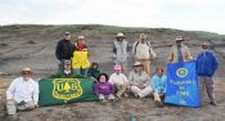Loch Ness Monster - Passport in Time
Main menu:
PIT Highlights > Headlines > 2015
Type of Loch Ness monster fossil found
Nebraska National Forest, South Dakota, 2015
by Cydney D. Janssen, National Forest Service
Published 10/5/2015 North Platte Bulletin - State/Regional News

Reid Cummins, front row center, with some of his co-workers. (Courtesy PhotoImage)
Some rare finds were reported by Reid Cummins earlier this year during a paleontology Passport in Time project he and Barb Beasley led near Ardmore, S.D.
Cummins calls the project a great success.
“We discovered some rare and very interesting finds and surprising trends,” he said “The biggest find was a gastrolith, a stomach stone similar to a gizzard stone, from a plesiosaur, which is like the Loch Ness monster – a marine reptile with a long neck, long tail and paddles.”
Cummins said the find is fairly rare, and they also found other fossil specimens including a pteranodon, a large flying, fish-eating reptile; fossil fragments from two turtles; a large variety of baculite fossils; and corpolites, fossilized poop, some of which contained bone fragments inside.
“This is all very exciting since we had mostly expected to find the fossil remains of mosasaurs, fish and sharks,” Cummins said.
Cummins is studying for a Masters of Science in Paleontology at the South Dakota School of Mines & Technology. He is from Lancaster, Penn.
Cummins was extremely excited to co-lead this one-of-a-kind field project as he has a condition known as dwarfism that hindered his growth, so that he reached a full height of three feet, one inch. The disability limits his mobility and ability to perform a significant amount of field work for his degree.
Earlier this spring, U.S. Forest Service Paleontologist Barb Beasley said she and Cummings academic advisor at SD Mines Sally Shelton worked with him to gather the research specimens. Together, they planned a six-day project in July at the Wallace Ranch Paleontological Special Interest Area, an accessible and fossil-rich site.
Beasley planned a Passport in Time project to provide volunteers to work with Cummins to collect specimens for his research. Cummins was in charge of the volunteers and provided oversight as they worked with him to collect the data for his project.
A total of 14 volunteers participated from Washington, Minnesota, Colorado, Pennsylvania and Georgia. One day they were also joined by eight 4-H leaders and members. Regardless of the bugs, wind, extreme heat, rain and hail, the volunteers were excited participants because they felt their work ‘really mattered.’
The data needed for Cummins thesis included counting and identifying fossil specimens in conjunction with the bentonite (layers of decomposed volcanic ash) to try to determine if the volcanic ash that fell through the Western Interior Sea affected the marine fauna.
The area has experienced six volcanic ash-fall events during the time of the deposition of the Pierre Shale at this particular site.
When asked ‘what’s next,’ Cummins said, “I need to calculate and analyze the data, write a thesis and prepare to defend it by the end of the year. My course work is completed so I can really focus.”
He also noted that all of the raw data, finished products, and specimen collection reports are the property of the U.S. Forest Service and housed at SD Mines. Reid also wishes to express his gratitude and appreciation to all of the volunteers who participated in the project, “I could not have done it without them,” he said.
Reid’s father, Dwight Cummins, an employee of Frontier Communications in Lancaster, Penn. was one of the volunteers.
He said, “I’m overwhelmed by the support Reid has to gather the research he needs for his master’s degree. It’s inspiring to see how many people are willing to help him be successful. I’m really stunned by the camp; it’s literally a ‘Spa’ of field camps – with the covered cook tent, showers, portapotties and full-time caterer – literally in the middle of nowhere!”